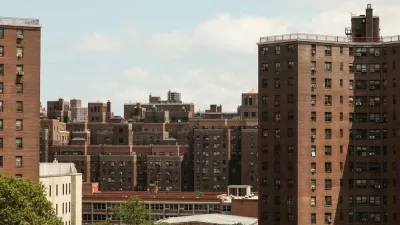The cost of housing affects millions across the country, but the issue has been conspicuously absent in the campaigns. Hillary Clinton's plan includes an imprecise remedy, while Donald Trump's pronouncements have been vaguer still.

Daniel J. McGraw laments the lack of attention given to affordable housing during this year's boisterous presidential campaigning. He notes, with some understatement, "this election has become more about the personalities of the candidates and the latest campaign gaffes than any real discussion of important issues."
And the issue is important, as most of us are acutely aware. "According to a Harvard report this year, 11.4 million households pay more than half their income for housing, and the number of those who spend more than 30 percent of their income on housing has reached 21.3 million."
Moreover, according to Angela Boyd, managing director of the Make Room campaign, "About 90 percent of the rental housing market being built right now is for luxury, and a whole segment of the population is being overlooked."
Both candidates have addressed the issue to a certain extent. And, no surprise, Hillary Clinton's plan has a bit more meat to it. "Democratic presidential candidate Hillary Clinton's plan would try to lift more families into sustainable homeownership through a $25 billion housing investment program that would include low-income housing tax credits and down payment assistance."
Meanwhile, Donald Trump maintains that lowering taxes will spur growth extending to the housing market. "Trump has yet to lay out a full plan with specifics, such as how to reduce spending to pay for the income tax decreases."
FULL STORY: Affordable Housing Gets 2016 Presidential Election Bump

Planetizen Federal Action Tracker
A weekly monitor of how Trump’s orders and actions are impacting planners and planning in America.

San Francisco's School District Spent $105M To Build Affordable Housing for Teachers — And That's Just the Beginning
SFUSD joins a growing list of school districts using their land holdings to address housing affordability challenges faced by their own employees.

The Tiny, Adorable $7,000 Car Turning Japan Onto EVs
The single seat Mibot charges from a regular plug as quickly as an iPad, and is about half the price of an average EV.

Seattle's Plan for Adopting Driverless Cars
Equity, safety, accessibility and affordability are front of mind as the city prepares for robotaxis and other autonomous vehicles.

As Trump Phases Out FEMA, Is It Time to Flee the Floodplains?
With less federal funding available for disaster relief efforts, the need to relocate at-risk communities is more urgent than ever.

With Protected Lanes, 460% More People Commute by Bike
For those needing more ammo, more data proving what we already knew is here.
Urban Design for Planners 1: Software Tools
This six-course series explores essential urban design concepts using open source software and equips planners with the tools they need to participate fully in the urban design process.
Planning for Universal Design
Learn the tools for implementing Universal Design in planning regulations.
Smith Gee Studio
City of Charlotte
City of Camden Redevelopment Agency
City of Astoria
Transportation Research & Education Center (TREC) at Portland State University
US High Speed Rail Association
City of Camden Redevelopment Agency
Municipality of Princeton (NJ)




























